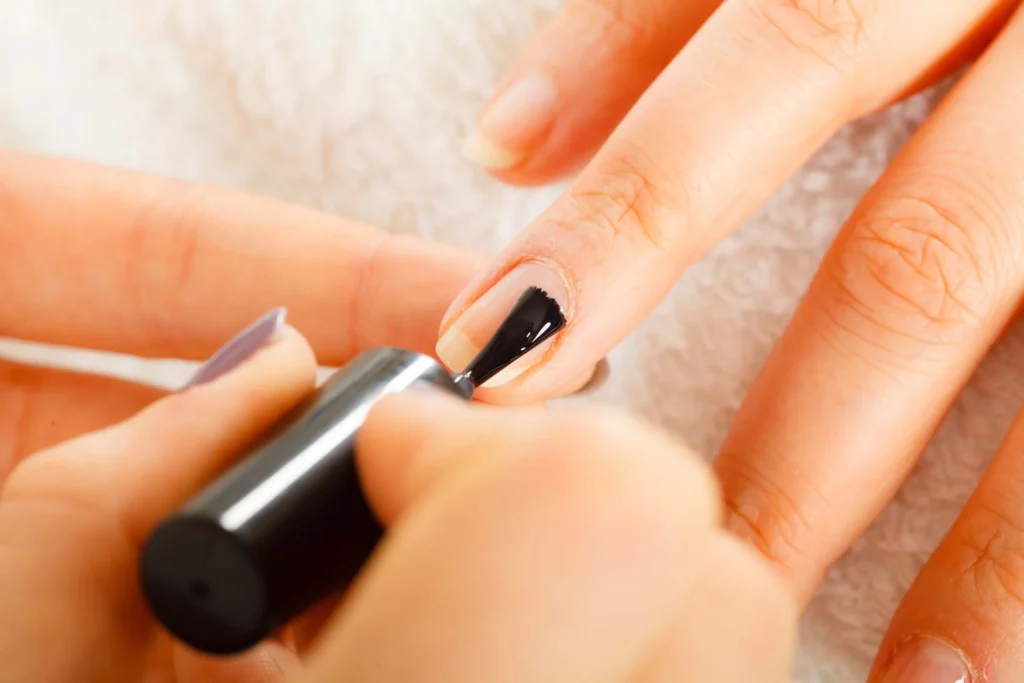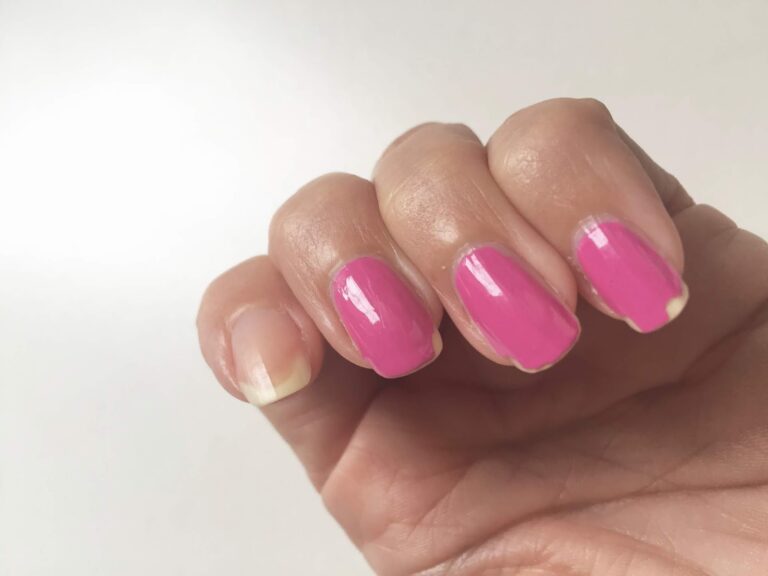Using a base coat as a top coat isn’t advisable due to their differing purposes and compositions. Base coats are meant to prepare nails, offering strength, preventing staining, and enhancing polish adhesion. In contrast, top coats protect polish, providing gloss, quick drying, and chip resistance. While a base coat might serve temporarily as a top coat, it won’t offer the same shine, durability, or quick-drying capabilities.
Opting for a proper top coat ensures better results, maintaining polish integrity and longevity. Ultimately, using products for their intended purposes yields optimal nail care outcomes.
What distinguishes base coats from top coats in nail care?
These differences in composition, functionalities, and key ingredients between base coats and top coats emphasizes their unique roles in nail care and why using a dedicated top coat is essential for optimal results and nail health.
Composition and Formulation Variations

Base Coats
Base coats are formulated to create an adhesive surface on the nail bed. They typically contain ingredients like adhesive polymers, resins, and proteins that help in adhering nail polish to the nails.
Many base coats also contain ridge-fillers to create a smooth canvas for polish application.
Some base coats may include nail-strengthening components such as calcium, keratin, or vitamins to improve nail health.
Top Coats
Top coats are designed to provide a protective layer over the nail polish. They often contain fast-drying agents, such as solvents like ethyl acetate or butyl acetate, that help the polish dry quickly.
Top coats include ingredients like film-forming polymers and silicones that create a durable and glossy finish. UV inhibitors are sometimes present in top coats to prevent nail polish from yellowing or fading when exposed to sunlight.
Specific Roles and Functionalities of Each
Base Coats
- Prepares the nails by creating an even surface and promoting better adhesion of nail polish.
- Helps prevent staining of nails, particularly from highly pigmented nail polishes.
- Can enhance the wear time of nail polish by providing a stable base.
Top Coats
- Protects nail polish from chipping, smudging, and scratching.
- Provides a high-shine, glossy finish to the nail polish.
- Helps in accelerating the drying process of nail polish layers.
Key Ingredients and Their Purposes in Base Coats and Top Coats
Base Coats
- Adhesive polymers and resins – promote polish adhesion.
- Nail-strengthening components like calcium, keratin, or vitamins – improve nail health.
- Ridge-fillers – create a smooth surface for polish application.
Top Coats
- Fast-drying agents like solvents – aid in quick drying of nail polish layers.
- Film-forming polymers and silicones – create a protective layer and impart glossiness.
- UV inhibitors – prevent nail polish discoloration when exposed to sunlight.
How does using a base coat as a top coat impact nail polish performance?
While using a base coat as a top coat might seem like a temporary solution, it’s important to note that the performance and results may not match those achieved with a dedicated top coat designed specifically for providing gloss, protection, and durability to nail polish.
Possible Reasons for Considering This Substitution
Emergencies or Convenience
One might consider using a base coat as a top coat in situations where a dedicated top coat isn’t available. This can be due to convenience or emergencies, such as running out of top coat or being unable to access a store.
Similarity in Appearance
Some base coats and top coats may appear visually similar, leading individuals to consider using a base coat as a substitute for a top coat.
Experimentation
Nail enthusiasts or professionals might experiment with base coats as top coats to explore alternative techniques or effects in nail art or polish application.
Potential Drawbacks and Limitations
Lack of Gloss and Finish
Base coats are not formulated to provide the same level of gloss or shine as top coats. Using a base coat in place of a top coat may result in a less glossy or shiny appearance on the nails.
Durability and Wear
Base coats may not offer the same durability and wear-resistance as top coats. They may be more prone to chipping, smudging, or wearing off quicker when used as a top coat.
Drying Time
Base coats might not have the same fast-drying agents present in top coats, leading to longer drying times. This could potentially result in smudges or imperfections if the nails aren’t allowed adequate drying time.
Expected Differences in Performance and Results
Gloss and Shine
Using a base coat as a top coat might result in a less glossy or shiny finish compared to using a dedicated top coat product. Top coats are specifically formulated to enhance shine and glossiness.
Protection and Longevity
A base coat might not provide the same level of protection against chipping, smudging, or extending the wear-time of nail polish as a proper top coat would.
Drying Properties
Base coats may not contain the same fast-drying agents as top coats, leading to longer drying times and potentially affecting the overall finish and appearance of the nail polish layers.
What importance lies in using designated top coats?

Adhering to these recommended practices by using designated products, focusing on proper application techniques.
Importance of Using Designated Products for Their Intended Purposes
Using designated base coats and top coats ensures that each product serves its intended purpose effectively. Base coats prepare the nail surface for polish application, while top coats provide protection and shine.
Base coats and top coats contain specific ingredients tailored to their functions. Base coats have adhesive properties and nail-strengthening components, while top coats contain fast-drying agents and gloss-enhancing elements.
Using the right products helps maintain nail health. Base coats may contain ingredients that strengthen nails, while top coats offer protection against external elements, preventing chipping and extending the life of the manicure.
Advantages of Utilizing a Proper Top Coat
A proper top coat acts as a shield, protecting nail polish from chipping, smudging, and scratches. It significantly enhances the durability of the manicure, prolonging its wear time.
Top coats are specifically formulated to provide a high-gloss, shiny finish to nail polish. They enhance the overall appearance of the manicure, giving it a professional and polished look.
Many top coats contain fast-drying agents that help the nail polish layers dry faster, reducing the risk of smudges and ensuring a smooth, flawless finish.
Optimal Nail Care Practices for Enhancing Polish Longevity and Appearance
Apply thin, even layers of base coat, nail polish, and top coat to ensure proper adhesion, color payoff, and protection. Allow each layer to dry completely before applying the next.
Refresh the top coat every few days to maintain the manicure’s shine and durability. Gently apply a new layer of top coat to protect the existing polish.
Take breaks between manicures to allow nails to breathe and recover. Use nourishing nail oils or moisturizers to keep cuticles and nails hydrated and healthy.
Limit exposure to harsh chemicals, such as detergents or cleaning agents, which can weaken nails and cause polish to chip or peel prematurely.
FAQ’s
Can I use base coat by itself?
Yes, you can apply a base coat by itself for a natural, subtle look while also providing some protection and strength to your nails.
Is a top coat necessary?
A top coat isn’t mandatory, but it offers protection, shine, and prolongs the wear of your nail polish, enhancing the overall look and durability of your manicure.
Is base and top coat the same?
No, base coats and top coats differ significantly. Base coats prepare the nail surface, while top coats protect the polish, provide shine, and prevent chipping.
Do you need both base coat and top coat?
Using both is recommended for the best results. A base coat helps polish adhere better, while a top coat adds protection and a glossy finish, ensuring a longer-lasting manicure.
Does base coat damage nails?
Generally, base coats are formulated to protect and strengthen nails. However, improper application or using certain formulations might potentially weaken nails.
Does base coat need UV?
Base coats typically don’t require UV light to dry. They often air-dry and don’t necessitate UV exposure for the curing process like some gel nail polishes.
Final Words
In conclusion, using a base coat as a top coat isn’t the best choice because they’re meant for different jobs. Base coats prepare your nails for polish, while top coats protect the polish and make it shiny. Base coats lack the quick-drying and protective qualities of top coats, so they might not give the same glossy finish or durability. It’s important to use the right products for better results and to take care of your nails.
Top coats keep your nail polish safe from chipping and make it look nice and shiny, while following good nail care practices helps your manicure last longer and keeps your nails healthy. Stick to using a proper top coat for the best-looking and longest-lasting nails.

